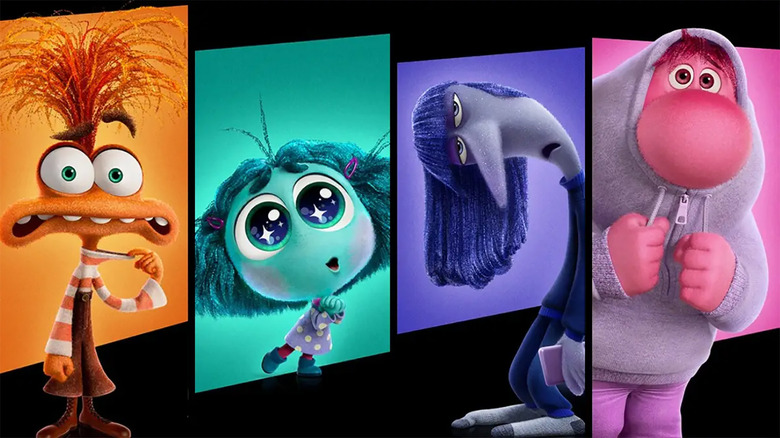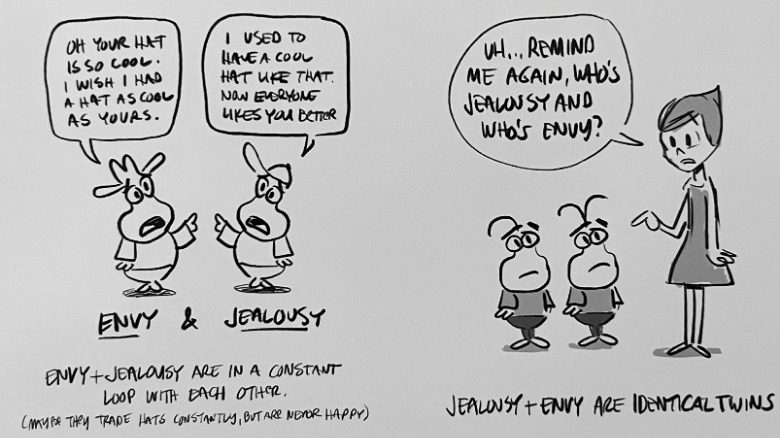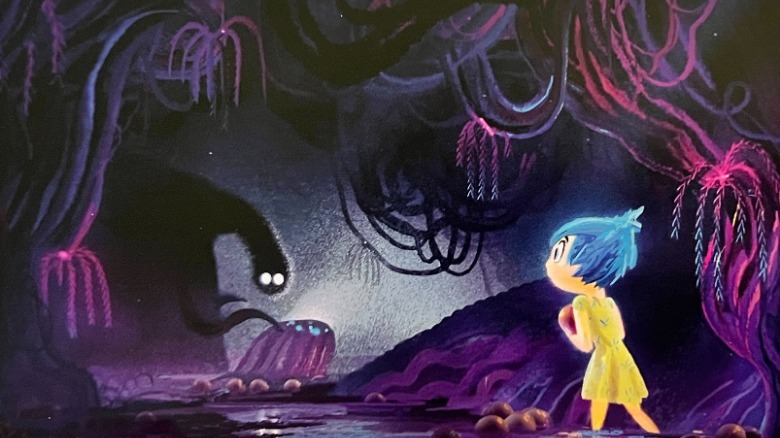Jealousy And Shame Came Close To Being New Emotions In Inside Out 2
Beware, this article has spoilers for "Inside Out 2."
Pixar's "Inside Out 2" arrives in theaters this weekend, and while it doesn't quite measure up to the greatness of the original, it will still reduce you to tears. The sequel takes us back into the mind of Riley, who is now 13 years old and starting to experience the complications of growing up. That means coming to terms with some new emotions, and she's not the only one struggling. Joy (Amy Poehler), Sadness (Phyllis Smith), Anger (Lewis Black), Disgust (Liza Lapira), and Fear (Tony Hale) have to deal with the fact that they're starting to lose control of Riley's mind when Anxiety (Maya Hawke), Envy (Ayo Edebiri), Ennui (Adèle Exarchopoulos), and Embarrassment (Paul Walter Hauser) show up and make things much more difficult to manage.
However, during the long development process for "Inside Out 2," plenty of other new emotions were also considered. As we learned during a press day at Pixar Animation studios earlier this year, there were once nine new emotions entering Riley's mind. We've heard about how Schadenfreude almost made it into the movie, as well as Guilt, but it turns out Jealousy and Shame were also among the new arrivals. If that sounds like too many new emotions, you're right. That's partially why the number was carefully pared down. Thankfully, director Kelsey Mann got more specific about why those two emotions ended up getting booted from the movie.
Jealousy was too close to Envy
In "The Art of Inside Out 2," available on shelves now, you can see some concept art of Jealousy. You might be thinking that this character sounds too close to Envy, who ended up in the movie, and that was part of the problem. Mann explained in an excerpt in the book:
"In the early drafts of the script, we tried having the Emotion of Jealousy show up in Headquarters. So much of being a teenager is all about comparing yourself to others, and that's exactly what Jealousy does. But ultimately, we found the character hard to like, or even understand specifically the concept of Jealousy as an Emotion. A lot of people confuse jealousy and envy. We even played with the idea of them being identical twins that no one could tell apart."
"Inside Out 2" is about how anxiety gets the better of us, and in Riley's case, it causes her to question her own identity, and it turns her into a completely different person. While it's easy to see how Jealousy could have helped influence that, Envy serves a similar purpose in the film, essentially acting as Anxiety's enabling right-hand helper. Though it might have been fun to see the gags that would have emerged from both Envy and Jealousy being present, it's already difficult enough getting kids to understand complex emotions like Anxiety, so adding something potentially confusing to the mix wouldn't have helped strengthen the story. Speaking of which, it seems like early versions of "Inside Out 2" might have had a much different antagonist than Anxiety.
Shame had a much bigger role in early versions of Inside Out 2
Also in "The Art of Inside Out 2," there are several pieces featuring Shame, who was not only meant to be a new emotion in the movie but was seemingly once the film's antagonist. Here's what Mann had to say about Shame's presence in the movie:
"In the early days of development, we had the emotion of Shame in the film. Since we were telling a story of not feeling good enough, we thought it was a key emotion to include. But as we tried to incorporate her into the story, we found that she came off very arch — like a cartoony villain who didn't love and care for Riley and who just wanted to see her fail. It did teach us the lesson that all of Riley's emotions need to come from a place of love for her, even our antagonist."
As you can see, Shame even had her own lair, and it's likely that Shame also had a hand in Riley's crisis of identity, as she suddenly stops believing in herself when Anxiety takes over. Shame could have easily fueled that feeling, but trying to figure out how Shame worked with the rest of the emotions was clearly too difficult. Mann explained more to The Wrap in an interview about Shame's presence in the film and why it just didn't work:
"It was not fun to watch. It was too heavy. You know when you see a good movie and you're like, 'Man that was a great movie.' You want to see it again? 'No, not really.' There are movies like that. I don't want to make that movie. I want to make a movie that's really meaningful and when you're asked, 'Do you want to see that movie again?' You say, 'Yes!' Because those are my favorite movies. And those are the kinds of movies I want to make. And I did not want to return to that movie with that character. It's not that funny."
'Anxiety is in all of us'
Production designer Jason Deamer, who is also an art director at character designer at Pixar, echoed those sentiments, telling The Wrap, "Shame is a real thing in life, but not everybody goes through that. But anxiety is in all of us. It's just better. I think it's a more important thing to talk about than some kind of message about don't shame yourself. It was preachy. Anxiety, you need it. It's not 100% bad."
In the end, Anxiety thinks she's doing what's best for Riley by thinking about all the potential things that can go wrong with her life, and that results in Riley thinking that she's not good enough. That's something that we can all relate to as adults who have experienced various levels of insecurity during troublesome times. It's also a valuable lesson for kids to learn as they're starting to figure out who they are. Trying to use Shame to teach that lesson feels like a flawed approach, and it's Pixar's careful development process that helped them figure out the best approach to telling this story in a way that's sharp and sophisticated without being too difficult for kids to understand.
"Inside Out 2" is in theaters everywhere, and "The Art of Inside Out 2" is available to order right now.


